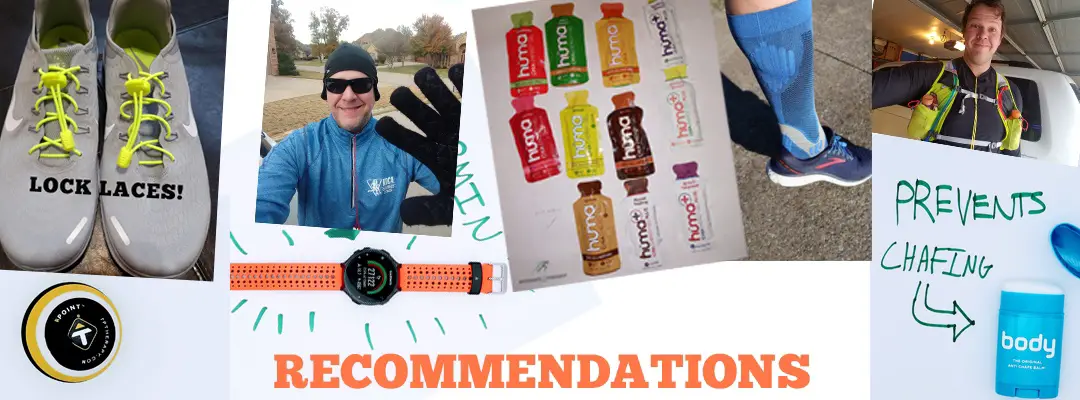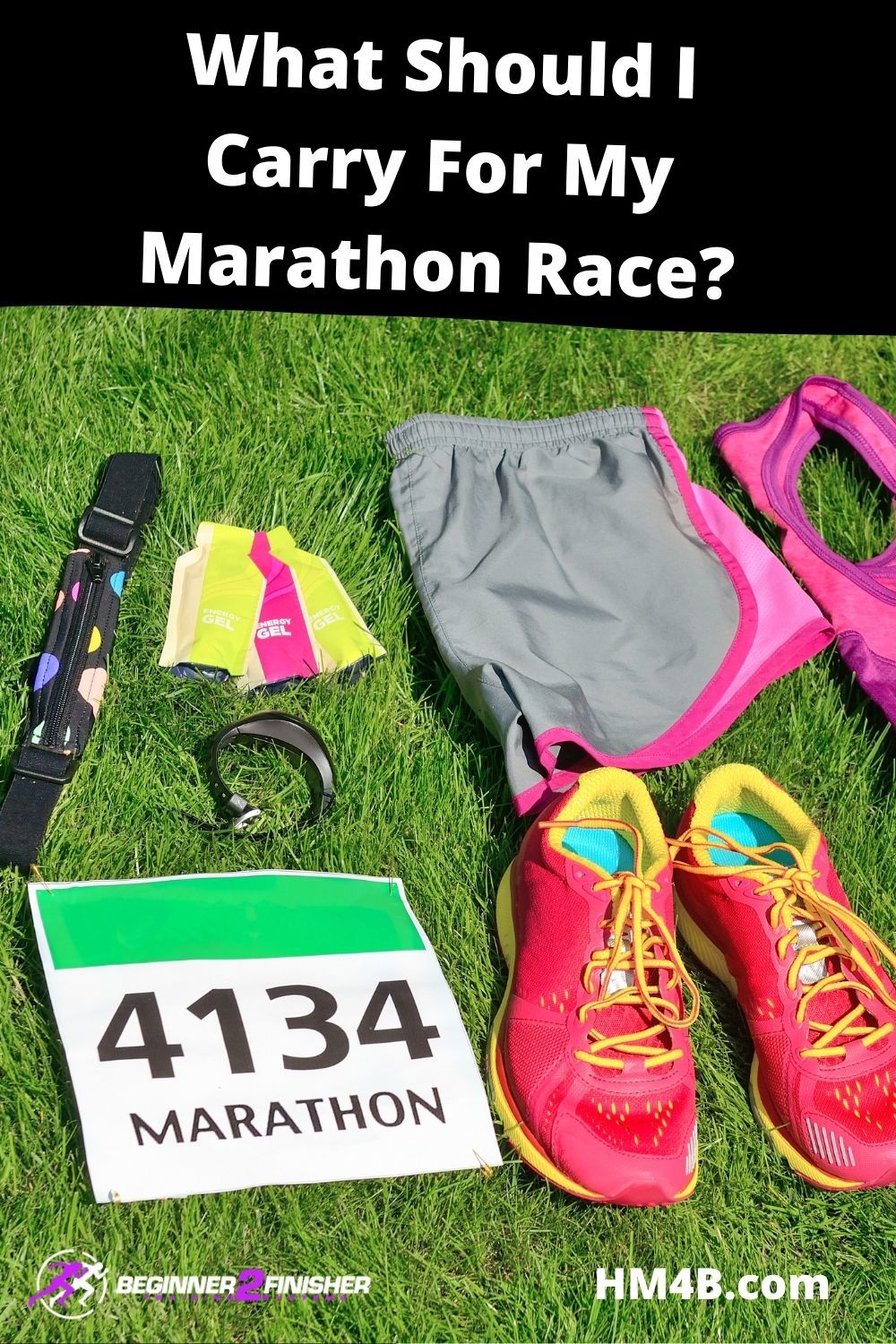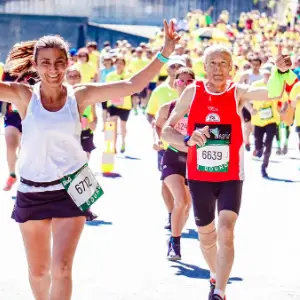Running a marathon is a big undertaking that requires a lot of training, but it is also important to remember all the details outside of the actual running. You’ll need to consider what you wear, fuelling, and taking care of injuries, so preparing for a race takes a lot of thought. When planning for a race, you need to ask yourself “What should I carry during a marathon race?”
While the items you carry will be different per runner, most will carry food and liquids (for fuelling), medical equipment (for things like blisters), and potentially a phone or watch to track your run and play music.
Essentials to carry during a marathon
So, what are the basics that all runner needs to remember before they run their marathon race?
Food
Whatever foods work for you (see below), it will be important to carry some food with you. While you might want to keep this to a minimum, you can never be 100% sure what food will be available on course, so you cannot leave it totally to chance. Also, taking food that you haven’t tested during training is a big no-no. Most big races will tell you what brand of energy gels they will provide during the race if any at all.
Liquid
Some will just prefer water, others will want energy or sports drinks. Whatever your preference, unless you are an elite runner that knows the exact detail of the course and water stations, it’s important you start out the race with some type of liquid on you, that can be topped off as you run.
Blister care
Particularly important for the new runner, having an appropriate bandage on you will be good if you cannot run through the pain of a blister.
Body glide/lube
While you don’t necessarily need to carry an anti-chaffing cream/solution with you, you should apply this to your inner thighs prior to racing especially if this is your first race. Some racers don’t incur any type of chafing while others will have super irritated red skin after running a marathon race.
For more info about chafing and what causes it, check out my detailed article about Chafing and how to prevent it.
Other potential items to carry during the marathon
A few other, less essential items you might carry with you on the course.
Smartphone – Often an alternative to watches for tracking progress or for others, carried so they can listen to music while running.
Related Post: 7 Best Ways To Carry Your Phone When You Run (especially racing)
Keys or money – Depending on storage options, you might need to carry a key or cash. It’s preferable to avoid or keep as small as possible
Bib / Timing chip – Normally attached to your running top or shorts
Related: How To Attach A Race Bib Without Safety Pins
Medication – Some people will need to carry essential medication, not specific to running
Running Watch – The running watch is slowly replacing the need to carry a smartphone. Some of the newer watches can now store music on your smartwatch for playback without the need for a phone to be nearby.
For a great review of the best marathon/half marathon training watches check out Best Marathon Training Watches For Runners.
For a complete list of items to bring to your half marathon or marathon race check out my half marathon checklist post.
Running attire is not a fashion statement
While it is lovely to look good in your running outfit, more important is that they cover all the practical elements that matter to you, as they are there to aid your race and performance.
Marathon Shoes
The MOST important item to get right. Do not change your shoes in the weeks leading up to a race, you should have picked the right footwear early. Never, ever wear a new pair of shoes to your marathon race. Your shoes should roughly have about 15-20% treadwear on them before racing in them. The average life expectancy of a running shoe tends to be about 400 miles so this would equate to about 60 to 80 running miles (When to retire your running shoes). Unless you’re an elite runner and have a separate pair of training shoes (trainers), always race in the same shoes you’ve trained in.
Shoes are designed for running styles. Go to a specialist and have them record your running form (gait analysis) so they can explain what running style you have and the shoes that work best for your particular style and/or form. You are going to be running for around 4 hours, getting the cheapest pair will not work and will likely cause you long-term problems.
I personally run in Brooks running shoes such as the Ghost 12/13 and the Glyscorein 11 (recommendations page).
Marathon Socks
People always forget about socks and wear generic running ones. You need ones that work for the conditions and your running style. Are you look for warmth or do you need ones that won’t retain the heat? Those are the questions you answer before selecting the right ones.
I personally run in Belga socks (recommendations page) and Brooks actually makes a good pair of racing socks.
Marathon Shorts and Tops
Weather conditions will dictate your clothing choice more than looks, but once you’ve picked the right tops and shorts for the weather, you should try running with tighter and looser styles to see which you find more comfortable and don’t lead to chafing.
Preparing for different marathon weather conditions
Unfortunately, marathons are not always run on perfectly calm days in early May or late September. While you will see the elite and professional runners out in the same running vests if it’s raining, snowing, blowing a gale or the sun is beating down, for the average runner it is important to adjust your gear accordingly.
Rainy days
First, think about footwear and ones that have good traction, meaning you have a far less chance of slipping. Good compression shorts will help avoid chafing, which is more likely in wet conditions.
You are not going for a walk up a hill where you can gradually shed clothes if you get too hot, out on the course you have to carry what you are running with, meaning you need to respect how warm it is and only wear enough to protect from the rain without overheating.
A good example might be a base layer of a t-shirt and a waterproof shell layer on top. A lot of people will also wear a cap to avoid the rain coming directly into their eyes as they run.
For more tips about specific gear to wear in the rain check out – What Should I wear if I Run in the Rain?
Snow and cold conditions
It will be about choosing gear that keeps warmth in and snow, water, or slush out. For example, trainers focus on ones with the least mesh possible. For socks, focus on good quality SmartWool ones.
The most important element is remembering you will warm up. A tip is to often dress as if it’s 10 degrees warmer. You should start out cold, otherwise, you will overheat quickly.
For a detailed post of the dos and don’ts of running in cold weather, check out:
How To Run In Cold Weather – Beginner’s Guide
Windy
Most of the tips around cold and wet conditions apply here, but another great idea is to run in groups. You will be protecting each other, just remember to rotate who is at the front or the sides! You’ll need to take into account that you will be running slower in a headwind (coming at you) than running in a tailwind (wind pushing you forward)
Sunny
Running in hot conditions is probably the most dangerous running weather because you have the combined issues of overheating, sunstroke, sunburn, and dehydration.
Go for looser and breathable running clothes. Aim for shadier parts of the course. Take on more liquids than on an average run. Wear a cap. Put on sunscreen – high factor, regardless of what you would normally apply.
Related: check out the best mineral-based sunscreens for runners.
You will naturally be losing more liquids when you run in the heat, therefore you need to consume more liquids to replenish your lost liquids. Also, replacing your electrolytes is extremely important, especially if you’ve been sweating a lot during your marathon or half marathon race.
What else do you need for the marathon race?
Once you have the essential clothing sorted, you have other accessories to consider, which will be personal choices.
Headwear is a key one. Woolly hats for warmth, caps for keeping the sun and rain at bay. Others might go for headbands that cover ears.
Some people will wear gloves for warmth on cold running days, others prefer running tops that will pull down over their hands.
Running watches are very popular, being a much easier way to track performance and how those negative splits are going.
How do I carry all this stuff during the marathon?
While some of the pre and post-race items can easily be stored at the race in a gear check bag, others need a secure location on your person.
Between those spare clothes, phones, food, liquids, medical equipment, and whatever else you have decided you need, that’s a lot to carry. It is vital to find a balance between what you carry and not giving yourself a disadvantage with a heavy pack.
One way to avoid being weighed down is by using a running belt (hydration belt) or a hydration pack/water pack. Both allow you to spread the weight evenly so it doesn’t feel like a hindrance.
The choice might depend on how much you carry. A good running belt is very useful but only carries so much, while you could find a good backpack that also has a water pack built-in, such as a Camelbak, so you will not need a water bottle. If I carry water during a marathon or half marathon race I always wear my CamelBak (Check out my recommendation page for a particular type).
For a more detailed review of the best hydration water packs for half marathon or marathon races, including budget choices, check out:
Best Hydration Water Packs For Half Marathon or Marathon Races
Before and after your marathon race
Warm-up routines are a critical part of your race success. Most events will have organized warmups and these are fine for getting the energy flowing, but you should have a pre-race routine that you should follow regardless.
This starts with food prior to the race. Like a lot of things, you should test out the food that works for you and when to eat it. Most recommendations say eating 1.5 to 2.5 hours before the race. What you eat will depend on personal tastes and the time of the race.\
Check out: What to eat for a marathon or half marathon race.
Your warm-up routine is about loosening up, it is not a rigorous exercise leaving you out of breath!
Post-race, taking on more liquids is critical and this should not be alcohol. A celebratory drink is fine but drinking excessively immediately after a race will be dangerous, the focus needs to be on replenishing liquids as you will have dehydrated on the course. You also need to eat good carbs post the race to repair those muscles.
It is also key to not sit around for several hours immediately afterward, you need to keep moving around where possible. If possible, nothing speeds up the recovery as well as an ice bath. It might be unpleasant but it will add so much benefit – long term.
Personal Care
The key thing about looking after your body for any race is preparation. The best things you can do to ensure you are looking after yourself are train properly, fuel yourself correctly, and wear the right equipment. Everything in this article will gear you towards looking after yourself.
One easy way to make sure your body is prepared for the race is to clip your toenails. I know it sounds silly but tidier toenails might be part of the secret sauce to reducing black toenails.
Finally, it’s important to use common sense on any marathon run. Respect what your body is telling you and if you need to slow down, take a rest or end your race, then you have to listen. The achievement of completing a marathon gives you a massive high, but ultimately it is not worth causing any permanent damage.
What should you eat during a marathon?
The food you eat will be 100% tailored to what works for you and for the novice there is only one way to know what is right – test, test, and test again.
If we assume you are going through a 16-week training program, you should be spending the first 8 weeks testing out different foods on your training runs (particularly your weekly long run) to see which gives you the most energy and which ones leave you feeling poorly or bloated.
The items to eat in any race will be gels, bars, or chews designed specifically for running. They will contain the right ingredients to fuel you in the race. But smaller snacks like jellybeans and other sweets will also be a good source of energy. Often a combination is what works best.
basic marathon fueling rules
Related: What Are The Rules For Running in The Park, Trails, Tracks, Roads, and Races?
Whichever foods you choose, here are a couple of basic marathon fueling rules that will help you:
Best Fuel = Combination of glucose and fructose
Use a combination of glucose and fructose. Most research indicates that a combination of these two will give you the best results. Nearly all gels, bars, and chews contain them
Rule of 15
For every 15 minutes you run, eat 15 grams of Carbohydrates. As a guide, most gels will contain up to 25 grams. Also, don’t forget energy drinks will also contain carbs as well
Start fueling early in the marathon
Start early and spread out when you eat. Small and often is the best approach. Waiting for halfway through a marathon to begin fueling can be devastating causing a greater chance of hitting the wall – hard!
For a detailed fueling guide, check my popular post: Should I carry running fuel for half marathon and marathon races.
Are you wondering which energy gel you should use, check out my exclusive study on Energy Gels and my favorite picks?
While you will prepare foods to carry with you, for some carrying too much on the course is not something they like, preferring to keep their load to a minimum. This is where food stations become an option.
Generally, the foods put out at food stations will be good for a runner, because these are being prepared by experienced volunteers who are runners themselves.
One thing you will often find at food stations that it is hard to carry yourself is fresh fruit. Biting into a fresh orange can give an instant refreshing hit and a banana is a stable of these races. With bananas, most stations will cut them into thirds. This is because a whole banana can be too much and will potentially bloat you.
| Help support me and subscribe to my YouTube channel. YouTube video - 30 ways to make your runs less painful! Coach Scott's Credentials:
|
To sign up for a FREE half marathon training schedule, log sheet, and pace predictor CLICK HERE.

Recommended gear for runners
Connect with me:
| facebook.com/BeginnerToFinisher/ |

